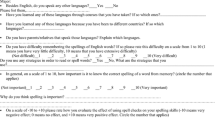Abstract
We assessed the effects of a computerized matching-to-sample procedure on the spelling performances of three students with mental retardation. Initially, the students could 1) match pictures and printed words to one another, and 2) match pictures and printed words to spoken words. However, they could not construct words to either pictures or spoken words (e.g., touch, in order, the letters s->h->o->e given the spoken-word sample “Shoe”). Word constructions then improved markedly after exposure to delayed constructed-response identity matching (e.g., touch the letters s->h->o->e given the printed-word sample shoe). One subject's oral and written spelling also improved. The results extend previous research by showing multiple positive effects of a computerized spelling intervention. These effects may have occurred in part because of the formation of stimulus classes among pictures, printed words, and spoken words.
Similar content being viewed by others
References
Dube, W. V., McDonald, S. J., McIlvane, W. J., & Mackay, H. A. (1991). Constructed-response matching to sample and spelling instruction.Journal of Applied Behavior Analysis, 24, 305–317.
Goldiamond, I. (1962). Perception. In A. J. Bachrach (Ed.),Experimental foundations of clinical psychology (pp. 280–340). New York: Basic Books.
Graham, S. (1983). Effective spelling instruction.The Elementary School Journal, 83, 560–567.
Graham, S., & Miller, L. (1979). Spelling research and practice: A unified approach.Focus on Exceptional Children, 12, 1–16.
Graham, S., & Voth, V. P. (1990). Spelling instruction: Making modifications for students with learning disabilities.Academic Therapy, 25, 447–457.
Heron, T. E., Okyere, B. A., & Miller, A. D. (1991). A taxonomy of approaches to teach spelling.Journal of Behavioral Education, 1, 117–130.
Horner, R. D., & Baer, D. M. (1978). Multiple-probe technique: A variation of the multiple baseline.Journal of Applied Behavior Analysis, 11, 189–196.
Kinney, P. G., Stevens, K. B., & Schuster, J. W. (1988). The effects of CAI and time delay: A systematic program for teaching spelling.Journal of Special Education Technology, 9, 61–72.
Lee, V. L., & Sanderson, G. M. (1987). Some contingencies of spelling.The Analysis of Verbal Behavior, 5, 1–13.
Mackay, H. A. (1985). Stimulus equivalence in rudimentary reading and spelling.Analysis and Intervention in Developmental Disabilities, 5, 373–387.
Mackay, H. A. (1991). Stimulus equivalence: Implications for the development of adaptive behavior. In R. Remington (Ed.),The challenge of severe mental handicap: An applied behaviour analytic approach (pp. 235–259). London, England: John Wiley & Sons.
Mackay, H. A., & Sidman, M. (1984). Teaching new behavior via equivalence relations. In P. H. Brooks, R. Sperber & C. MacCauley (Eds.),Learning and cognition in the mentally retarded (pp. 493–513). Hillsdale, NJ: Erlbaum.
Sidman, M. (1971). Reading and auditory-visual equivalences.Journal of Speech and Hearing Research, 14, 5–13.
Skinner, B. F. (1957).Verbal behavior. New York: Appleton-Century-Crofts.
Stevens, K. B., Blackhurst, A. E., & Slaton, D. B. (1991). Teaching memorized spelling with a microcomputer: Time delay and computer-assisted instruction.Journal of Applied Behavior Analysis, 24, 153–160.
Stromer, R. (1991). Stimulus equivalence: Implications for teaching. In W. Ishaq (Ed.),Human behavior in today's world (pp. 109–122). New York: Praeger.
Stromer, R., & Mackay, H. A. (1990). Arbitrary stimulus relations and delayed identity matching to complex samples.Experimental Analysis of Human Behavior Bulletin, 8, 22–25.
Stromer, R., & Mackay, H. A. (in press-a). Delayed identity matching to complex samples: Teaching students with mental retardation spelling and the prerequisites for equivalence classes.Research in Developmental Disabilities.
Stromer, R., & Mackay, H. A. (in press-b). Spelling and emergent picture-printed word relations established with delayed identity matching to complex samples.Journal of Applied Behavior Analysis.
Stromer, R., Mackay, H. A., & Stoddard, L. T. (in press). Classroom applications of stimulus equivalence technology.Journal of Behavioral Education.
Author information
Authors and Affiliations
Rights and permissions
About this article
Cite this article
Stromer, R., Mackay, H.A. Delayed constructed-response identity matching improves the spelling performance of students with mental retardation. J Behav Educ 2, 139–157 (1992). https://doi.org/10.1007/BF00947117
Accepted:
Issue Date:
DOI: https://doi.org/10.1007/BF00947117




